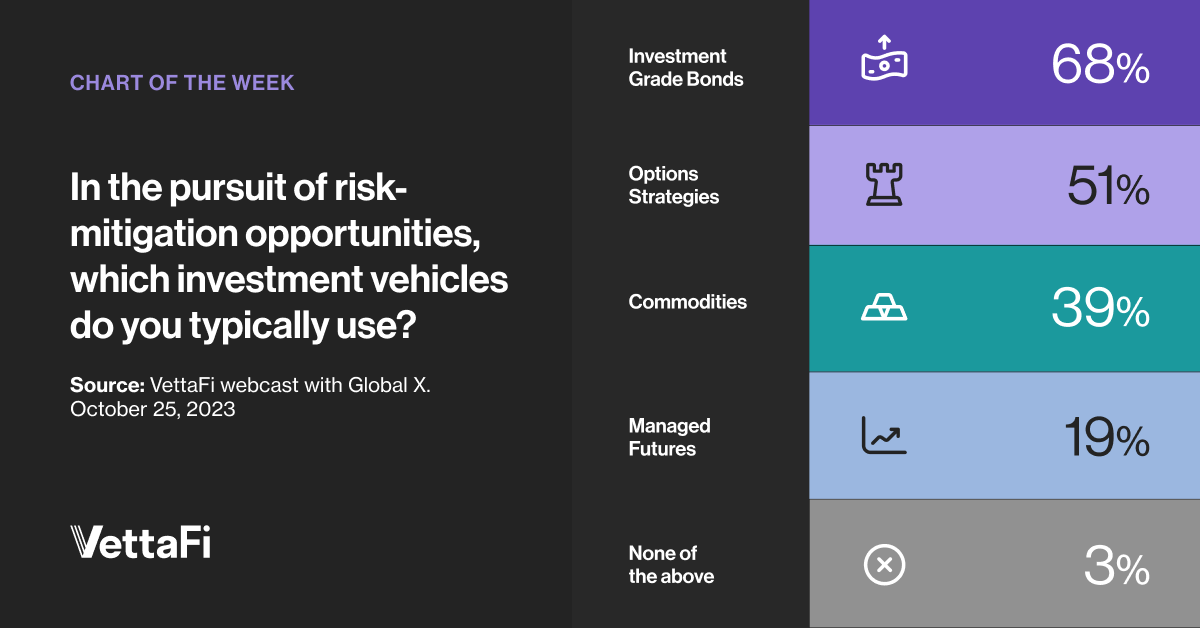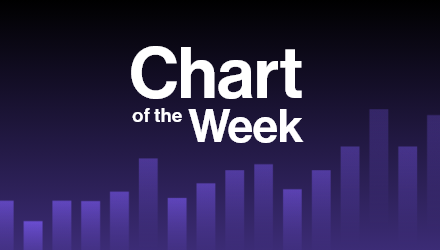The S&P 500 has rallied in recent days and was up close to 20% for the year. However, heading into 2024, many advisors are exploring a range of investment ideas that offer exposure beyond the stock market. The focus is on lowering the risk profile of the portfolio via diversification. In a late October webcast with Global X, we asked, “In the pursuit of risk-mitigation opportunities, which investment vehicles do you typically use?” The most frequently chosen answer was investment-grade bonds (68%) followed by options (51%). Commodities (39%) and managed futures (19%) were also being used.

Alternative Income and Investment-Grade Corporate Bonds in Demand
Investment-grade corporate bonds has been a popular choice in many VettaFi advisor surveys. We have written about the Vanguard Short-Term Corporate Bond ETF (VCSH) and its peers. VettaFi also covered advisors’ growing comfort in options strategies like the Global X S&P 500 Covered Call ETF (XYLD) and its brethren. These ETFs provide enhanced income by combining equity exposure with covered calls.
However, we saw in 2022 that stock-based and bond-based ETFs can go down sharply in value at the same time. XYLD and VCSH were down 12% and 5.6%, respectively. There are diversification benefits to adding an alternative like commodities or managed futures to a broader portfolio.
Do You Want Broad or Targeted Commodity Exposure?
The most popular commodity ETFs are focused on gold, led by the SPDR Gold Shares ETF (GLD). The fund was down 0.8% in 2022 and was up more than 7% as of mid-November 2023. GLD is the largest but also among the more expensive precious metals ETF. With a 0.40% fee, there are other lower-cost options than GLD. The iShares Gold Trust Micro (IAUM) is the cheapest of the bunch, with a 0.09% fee. There are five other gold ETFs available with expense ratios below 0.20% from abrdn, Franklin, Goldman Sachs, GraniteShares, and State Street Global Advisors.
Meanwhile, there are single commodity agriculture ETFs like the Teucrium Corn Fund (CORN). The fund was up 25% in 2023.
There are also many commodity ETFs available offering exposure to mix of commodities. For example, the abrdn Bloomberg All Commodity Strategy K-1 Free ETF (BCI) recently had 33% of assets in energy, 27% in agriculture, 20% in precious metals, 15% in industrial metals, and 5.7% in livestock commodities. Exposure to corn, copper, crude oil, gold, natural gas, silver, soybeans, and more provides significant diversification to a portfolio. BCI was up 15% in 2022.
Another example is the Direxion Auspice Broad Commodity Strategy ETF (COM). This ETF is different than an index-based approach like BCI. COM can be long or flat 12 commodities based on proprietary analysis in an attempt to avoid significant drawdown. For example, at the end of September, COM was long crude oil, heating oil, natural gas, sugar, and soybeans. However, it was flat copper, gold, silver,im g and some other agricultural commodities. COM was up 9.2% in 2022.
Managed Futures a Worthy Alternative
The iMGP DBi Managed Futures Strategy ETF (DBMF) was up 22% in 2023. The actively managed ETF uses long and short positions within futures and forward contracts. At the end of September, DBMF’s exposure included long international developed equities commodities and short currencies and fixed income. DBMF is a worthy candidate for 19% of the VettaFi survey respondents focused on managed futures.
The VettaFi Alternatives Symposium, taking place on November 28 at 11 a.m. ET, will be a great opportunity to hear from industry experts on commodities, managed futures, and a range of other investment approaches. Register today and obtain CE credits too.
For more news, information, and strategy, visit the Managed Futures Channel.

